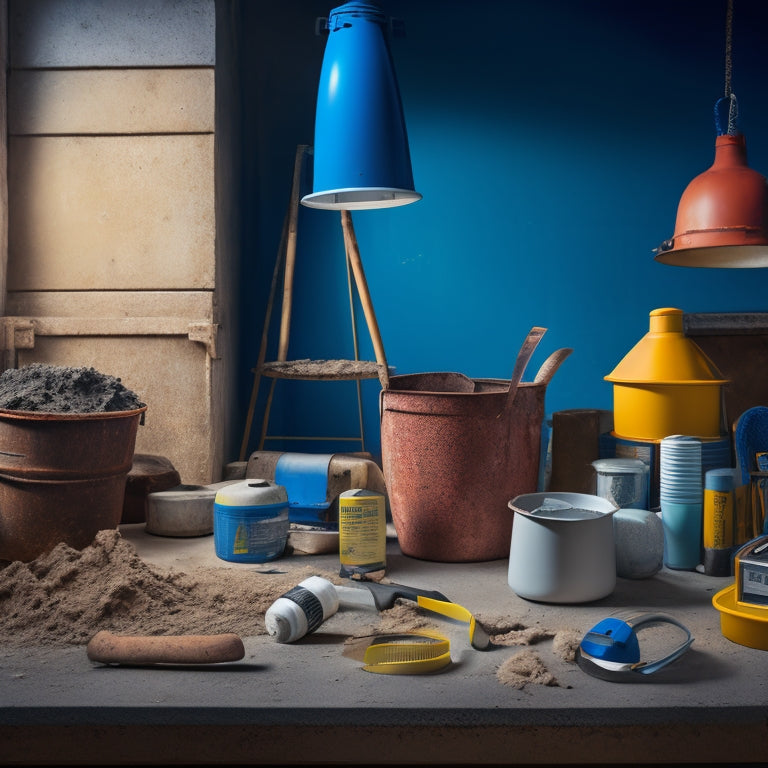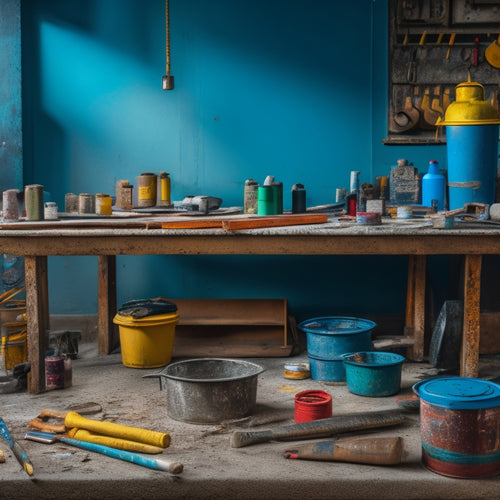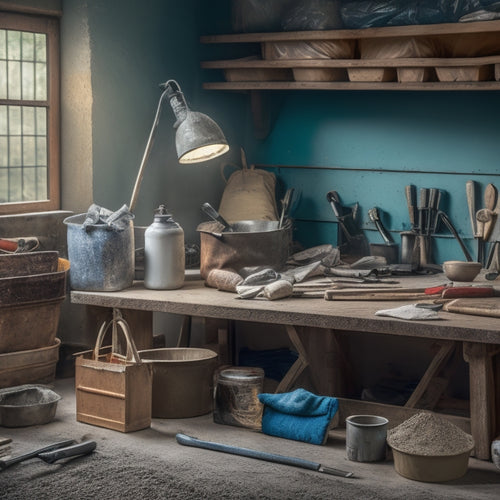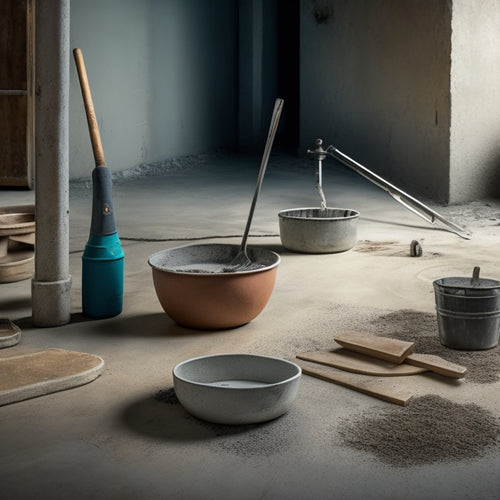
7 Must-Have Tools for Concrete Mixing Success
Share
When mixing concrete, you'll need a reliable set of tools to guarantee success. First, invest in a heavy-duty, UV-stabilized mixing bucket that's 1-2 gallons larger than the total mix volume. Next, choose a durable mixing paddle or efficient mixing stick that matches your bucket size. Accurate measuring tools, like digital scales, are also essential. Don't forget a heavy-duty wheelbarrow for easy material transportation. Additionally, protective gear, including hard hats and dust masks, will keep you safe on the job. Finally, a well-designed tamping tool will help you achieve a smooth finish. To master the art of concrete mixing, it's vital to have these must-haves in your toolkit - and understanding how to use them effectively is just the starting point.
Key Takeaways
• Select a heavy-duty, UV-stabilized polyethylene or polypropylene mixing bucket that is 1-2 gallons larger than the total volume of concrete mix.
• Choose a reliable concrete mixing paddle based on the size of the bucket and the batch size to ensure efficient and lump-free mixing.
• Invest in accurate measuring tools, such as digital scales, to ensure precision and consistency in concrete quality.
• Wear essential protective gear, including hard hats and dust masks, to safeguard against falling debris, dust, and respiratory issues.
• Use a sturdy wheelbarrow with a high weight capacity and comfortable handles to efficiently transport heavy loads of concrete mix.
Essential Mixing Bucket Requirements
You'll need a mixing bucket that meets specific requirements to guarantee efficient and effective concrete mixing.
The mixing bucket's material is essential, as it must withstand the abrasive nature of concrete and cleaning products. Look for buckets made from heavy-duty, UV-stabilized polyethylene or polypropylene, which can resist cracks and fading. Avoid using buckets with metal or wooden components, as they can react with the alkalinity of concrete or harbor moisture, leading to contamination.
Bucket size considerations are also important. Choose a bucket that's large enough to hold the required volume of concrete, but not so large that it becomes unwieldy or difficult to mix. A general rule of thumb is to select a bucket that's at least 1-2 gallons larger than the total volume of the concrete mix. This allows for easy mixing and minimizes the risk of overflow.
Additionally, consider the bucket's shape and design, ensuring it has a sturdy handle and a rim that's easy to grip and pour from. By selecting a mixing bucket that meets these requirements, you'll be well on your way to achieving successful concrete mixing results.
Reliable Concrete Mixing Paddles
Selecting a reliable concrete mixing paddle is vital to achieving a consistent, lump-free mix, as it helps to scrape the sides and bottom of the bucket efficiently. You'll want to choose a paddle that's durable, easy to clean, and comfortable to use. Take into account the paddle material types: steel, aluminum, or fiberglass. Each has its benefits, but steel paddles are the most durable and suitable for heavy-duty mixing.
When it comes to mixing paddle sizes, you'll need to reflect on the size of your bucket and the type of concrete you're mixing. Here's a breakdown of common paddle sizes and their uses:
| Paddle Size | Bucket Size | Mixing Capacity |
|---|---|---|
| 24' | 5-6 gallons | Small to medium batches |
| 30' | 10-12 gallons | Medium to large batches |
| 36' | 16-20 gallons | Large batches and heavy-duty mixing |
| 42' | 20+ gallons | Extra-large batches and heavy-duty mixing |
Remember to choose a paddle that's suitable for your mixing needs and comfortable for you to use. A reliable concrete mixing paddle is vital to achieving a consistent, high-quality mix.
Heavy-Duty Wheelbarrow Benefits
With heavy-duty mixing tasks requiring efficient transportation of materials, a sturdy wheelbarrow becomes an indispensable tool in your concrete mixing arsenal. You need a reliable and robust wheelbarrow to transport heavy loads of concrete, aggregates, and other materials around the construction site. A heavy-duty wheelbarrow offers numerous benefits that enhance your concrete mixing experience.
Here are some key advantages of using a heavy-duty wheelbarrow:
-
Weight capacity: A heavy-duty wheelbarrow has a higher weight capacity, allowing you to transport larger and heavier loads, reducing the number of trips you need to make.
-
Durability: A sturdy wheelbarrow is designed to withstand the rigors of heavy use, minimizing the risk of breakage and guaranteeing a longer lifespan.
-
Ease of use: A heavy-duty wheelbarrow is often equipped with features like large, sturdy wheels and comfortable handles, making it easier to maneuver around the site.
- Wheelbarrow maintenance: Regular maintenance of your wheelbarrow, such as lubricating the wheels and cleaning the tub, helps extend its lifespan and guarantees it remains in good working condition.
Accurate Measuring Tool Importance
When transporting heavy loads of concrete and aggregates around the site, a heavy-duty wheelbarrow's reliability is only as good as the accuracy of the measurements that go into the mix, making an accurate measuring tool an essential component of your concrete mixing process. You can't afford to compromise on measuring tape accuracy, as it directly affects the quality of your concrete. A slight miscalculation can lead to structural weaknesses, safety hazards, and costly rework.
To guarantee precision, consider investing in a digital scale with high precision. This will help you achieve the perfect ratio of cement, water, and aggregates. Here's a comparison of traditional versus digital measuring tools:
| Measuring Tool | Accuracy | Convenience |
| Traditional Measuring Tape | ±1-2% | Requires manual calculations |
| Digital Scale | ±0.1% | Automatic calculations and data storage |
| High-Precision Measuring Tape | ±0.5% | Requires manual calculations, but more accurate |
Efficient Mixing Stick Designs
You'll want to equip yourself with a mixing stick that's specifically designed for high-performance concrete mixing, as its unique features can greatly reduce mixing time and effort. A well-designed mixing stick can make all the difference in achieving a consistent, high-quality mix.
When selecting a mixing stick, consider the following key features:
-
Ergonomic handles: Look for handles that fit comfortably in your hand, reducing fatigue and strain. This is especially important for prolonged mixing sessions.
-
Flexible blades: Flexible blades can navigate through thick mixes with ease, ensuring a thorough blend of ingredients.
-
Durable construction: A mixing stick that can withstand the rigors of heavy use will save you time and money in the long run.
- Balanced design: A well-balanced mixing stick allows for smooth, efficient mixing, reducing the risk of accidents and injuries.
Protective Gear for Mixers
As you prepare to mix concrete, you'll need to prioritize your safety by donning the right protective gear.
You'll want to guarantee you're wearing a hard hat to safeguard your head from falling debris and a dust mask to prevent inhaling harmful particles.
Hard Hat Protection
Wearing a hard hat is vital for protecting your head from falling objects, debris, and other hazards that can cause serious injury or even death when mixing concrete. You can't afford to take any chances when it comes to your safety, and a hard hat is an important piece of protective gear that can literally save your life.
When it comes to choosing a hard hat, you'll want to take into account the following factors:
-
Compliance with safety regulations: Make sure your hard hat meets or exceeds the safety standards set by organizations such as OSHA and ANSI.
-
Type of hard hat: There are different types of hard hats, including Type I, which protects against falling objects, and Type II, which provides additional protection against lateral impact.
-
Fit and comfort: Choose a hard hat that fits snugly and comfortably, allowing you to focus on the task at hand.
- Maintenance and inspection: Regularly inspect your hard hat for signs of damage or wear, and replace it as needed to guarantee it continues to provide adequate protection.
Dust Mask Essentials
When mixing concrete, inhaling dust and particles can lead to respiratory issues, making a dust mask an essential protective gear for mixers to prevent airborne contaminants from entering their lungs.
You'll want to choose a dust mask that's suitable for the job, and there are several types to take into account. Half-face dust masks cover your nose and mouth, while full-face dust masks provide additional protection for your eyes. There are also different filter types, including particulate filters, chemical cartridges, and combination filters.
The benefits of wearing a dust mask are undeniable. By filtering out dust, particles, and other airborne contaminants, you'll reduce your risk of respiratory problems, such as asthma and silicosis.
You'll also be more comfortable on the job, with reduced coughing and sneezing. Additionally, a dust mask can help you stay focused on the task at hand, without worrying about the air you're breathing.
With so many dust mask options available, it's easy to find one that fits comfortably and meets your specific needs. By making a dust mask a non-negotiable part of your protective gear, you'll be well on your way to a safer, healthier mixing experience.
Essential Tamping Tool Features
You'll want to look for a tamping tool that boasts adjustable handle lengths and ergonomic grips to minimize fatigue and enhance control. This is vital for ensuring you can work efficiently and safely, even during extended periods of concrete mixing.
When it comes to tamping tool materials, prioritize durable and rust-resistant options like stainless steel or fiberglass. These materials can withstand the rigors of heavy use and harsh job site conditions.
Here are some essential features to look for in a tamping tool:
-
Ergonomic grip design: Reduces strain on your hands and wrists, allowing you to work comfortably for longer periods.
-
Adjustable handle length: Accommodates users of different heights and preferences, promoting ideal control and leverage.
-
Durable, rust-resistant materials: Withstands heavy use and harsh job site conditions, ensuring your tamping tool remains reliable over time.
- Balanced head design: Provides even weight distribution, making it easier to tamp concrete with precision and control.
Frequently Asked Questions
How Often Should I Clean My Concrete Mixing Tools?
You should clean your concrete mixing tools after every use to prevent concrete residue buildup. This daily cleaning frequency guarantees tool maintenance and prevents damage.
Remove excess concrete with a stiff brush or scraper, then wash with soap and water. Regular cleaning also reduces the risk of contamination and guarantees your tools are safe to use for the next project.
Can I Use a Drill as a Concrete Mixing Paddle?
You think you can just whip out your trusty drill and use it as a concrete mixing paddle? Well, technically, you can, but don't expect stellar mixing efficiency.
Drill specifications just aren't designed for the rigors of concrete mixing. You'll end up with a subpar mix and a worn-out drill.
Save yourself the hassle and invest in a proper mixing paddle designed for the job. Your safety and the quality of your concrete depend on it.
What Is the Ideal Temperature for Mixing Concrete?
When you're mixing concrete, the ideal temperature is essential.
You want to aim for a temperature between 50°F and 75°F (10°C and 24°C) for best mixing conditions. This range allows for proper hydration and strength development.
If the concrete temperature is too high or low, it can lead to weak or unstable structures.
Make certain to monitor the temperature to guarantee a safe and successful pour.
Can I Mix Concrete in a Metal Bucket?
You're about to stir up a concrete storm, but first, let's tackle the bucket dilemma!
When it comes to mixing concrete, you shouldn't be bucket-happy. Metal buckets can be a recipe for disaster, as they can react with the concrete's alkalinity, affecting its strength and structure.
Instead, opt for a sturdy, non-reactive bucket, like a plastic or rubber one, and pair it with proper mixing techniques to guarantee a solid foundation.
Safety first, right?
How Do I Prevent Concrete From Sticking to My Tools?
You're wise to wonder how to prevent concrete from sticking to your tools. To avoid this hassle, apply a concrete release agent to your tools before use. This guarantees a smooth release and prevents damage.
Regular tool maintenance is also essential; clean and oil your tools after each use to prevent concrete buildup.
Conclusion
With these 7 must-have tools, you'll be well on your way to concrete mixing success.
For instance, consider a construction project in Denver, Colorado, where a team of mixers used a reliable concrete mixing paddle to achieve a consistent mix. This resulted in a 20% reduction in material waste and a 15% increase in project efficiency.
By investing in the right tools, you can achieve similar results and take your concrete mixing skills to the next level.
Related Posts
-

Essential Tools for Painting Concrete Walls
When painting concrete walls, you'll need a range of specialized tools to achieve a professional-looking finish. Star...
-

10 Must-Have Tools for Small Concrete Projects
When tackling small concrete projects, you'll need a range of essential tools to achieve professional-grade results. ...
-

Why You Need These Concrete Overlay Tools
When tackling a concrete overlay project, you need the right tools to achieve a flawless finish and avoid costly mist...


